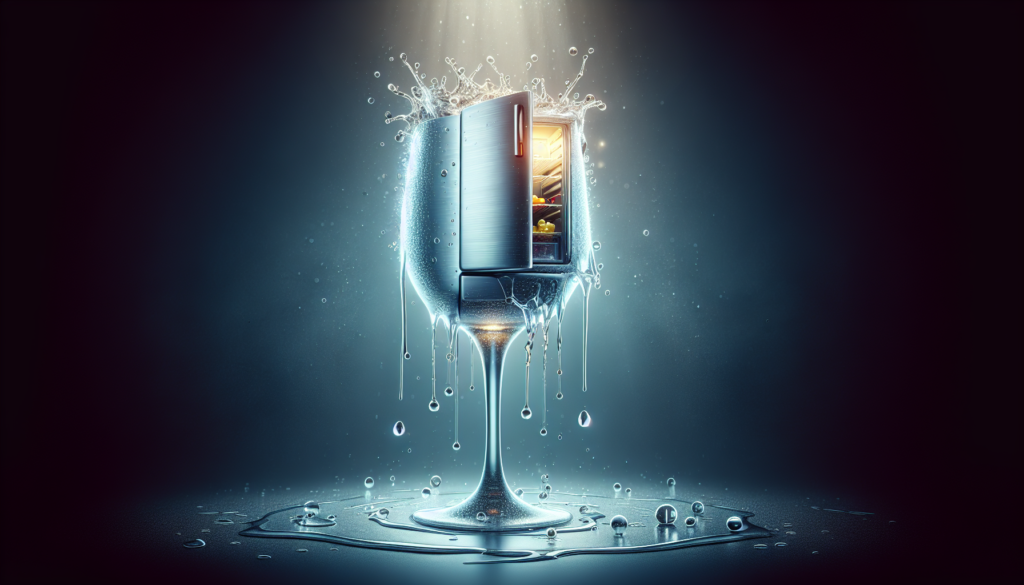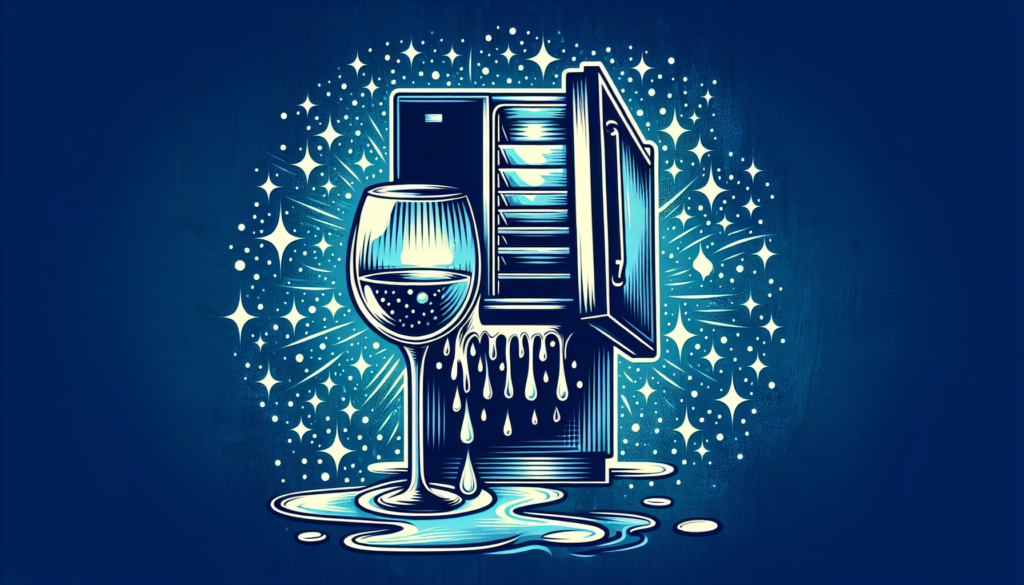Imagine this: you go to grab a bottle of your favorite wine from your wine fridge, only to find a small puddle of water on the floor. As you inspect further, you realize that your beloved wine fridge is leaking water. Don’t fret! In this article, you will discover the possible causes behind this frustrating problem and learn effective solutions to fix it. With our helpful tips, you’ll be back to enjoying your perfectly chilled wines in no time!
Why is my wine fridge leaking water?
If you’ve noticed water pooling around your wine fridge or coming from unexpected places, it’s important to address the issue as soon as possible. Leaking water can damage your wine collection and potentially cause other problems, so understanding the causes and finding solutions is crucial. In this article, we will delve into the various reasons why your wine fridge might be leaking water and provide comprehensive solutions to each issue. With this information, you can ensure that your wine fridge functions properly and keeps your valuable vintages safe.
Condensation buildup
Condensation buildup is a common cause of water leakage in wine fridges. As the temperature inside the fridge decreases, moisture from the air can accumulate on the walls or other surfaces, leading to water droplets forming and eventually causing leakage.
To prevent condensation buildup, it is important to maintain a consistent temperature in your wine fridge. Avoid frequent temperature fluctuations and keep the thermostat set at an appropriate level for the wines you are storing. Additionally, ensure proper ventilation around the fridge to minimize moisture content in the air. Placing a small dehumidifier near the unit can also help reduce excess moisture and condensation.

Leak from the water dispenser
Some wine fridges are equipped with water dispensers for added convenience. While this feature can be useful, it can also be a potential source of water leakage if not properly maintained or if there is an issue with the dispenser itself.
Causes of water dispenser leaks can include loose or damaged connections, worn-out valves, or faulty seals. To fix a water dispenser leak, start by inspecting the connections and tighten any loose fittings. If that doesn’t resolve the issue, consider replacing the faulty components or contacting a professional repair service for assistance.
Leak from the drain pan
The drain pan in a wine fridge is designed to collect excess water and condensation, preventing it from spilling onto the floor or damaging the unit. However, if the drain pan becomes cracked, damaged, or improperly positioned, it can lead to water leakage.
To resolve drain pan leaks, start by inspecting the pan for any visible damage or misalignment. If you notice any issues, try realigning the pan or replacing it, if necessary. It’s important to ensure that the drain pan is securely in place and properly connected to the drainage system.

Blocked drain tube
The drain tube in a wine fridge serves the important function of channeling excess water from the drain pan to the outside. If this tube becomes blocked or clogged, water can back up and eventually lead to leakage.
To identify a blocked drain tube, carefully inspect it for any visible obstructions. If you find any debris or blockages, gently clear them away using a long, flexible brush or pipe cleaner. Be cautious not to damage the tube while doing this. Once the blockage is cleared, test the drain tube by pouring a small amount of water into the drain pan and ensuring that it properly flows out through the tube.
Faulty door gasket
The door gasket, or seal, is responsible for maintaining a tight and secure closure of the wine fridge door. If the gasket becomes damaged, worn, or loose, it can allow cold air to escape and result in condensation buildup, potentially leading to water leakage.
Signs of a faulty door gasket include visible cracks, tears, or gaps. To replace a faulty door gasket, start by obtaining a compatible replacement from the manufacturer or an authorized retailer. Gently remove the old gasket, clean the area thoroughly, and carefully install the new one according to the manufacturer’s instructions. A properly fitted gasket should create a tight seal when the door is closed.
Excessive humidity in the room
Excessive humidity in the room where your wine fridge is located can contribute to condensation buildup and increased water leakage. High humidity levels can cause moisture to accumulate on the interior surfaces of the fridge, potentially leading to water pooling and other issues.
Reducing humidity in the room can be achieved by using a dehumidifier or improving ventilation. Ensure that the room is well-ventilated, and avoid placing the wine fridge in areas with high humidity sources such as laundry rooms or kitchens. Monitoring the room’s humidity levels with a hygrometer can also help you maintain an optimal environment for your wine fridge.
Malfunctioning defrost cycle
Most wine fridges are equipped with a defrost cycle that removes excess frost and ice buildup. If this defrost cycle malfunctions, it can lead to water leakage as the frost melts.
Symptoms of a malfunctioning defrost cycle may include excessive frost or ice buildup in the unit, erratic temperature fluctuations, or water pooling around the fridge. To fix a malfunctioning defrost cycle, consult the user manual for troubleshooting steps specific to your model or reach out to the manufacturer’s customer support for guidance. In some cases, a professional repair service may be needed to resolve the issue.
Improper installation
Improper installation of a wine fridge can also contribute to water leakage. If the unit is not leveled, installed too close to the wall, or placed on an uneven surface, it can disrupt the internal components and cause water to leak.
Common installation mistakes include failing to level the fridge, blocking air vents, or neglecting to leave sufficient clearance around the unit for proper airflow. To install a wine fridge correctly, carefully follow the manufacturer’s instructions and ensure it is placed on a stable, level surface with proper clearance. Allow ample space for air to circulate around the unit and avoid obstructing the vents.
Clogged air filter
The air filter in a wine fridge plays a crucial role in maintaining the unit’s efficiency and preventing dust, dirt, and other particles from entering. If the air filter becomes clogged or dirty, it can impede airflow and result in excessive condensation and water leakage.
To clean the air filter, consult the user manual for instructions specific to your model. In most cases, you can remove the filter and gently wash it with warm, soapy water. Allow it to air dry completely before reinstalling it. Regularly checking and cleaning the air filter can help prevent water leakage and ensure optimal performance of your wine fridge.
Cracked water line
If your wine fridge is equipped with a water line for ice makers or water dispensers, a cracked water line can be a potential source of water leakage.
Identifying a cracked water line can be challenging as it may be hidden behind the fridge or concealed within the unit. However, if you notice water leaking from the back of the fridge or near the water connection area, it may indicate a cracked water line.
Repairing a cracked water line typically requires professional assistance. Contact the manufacturer’s customer support or a qualified appliance repair service to assess and resolve the issue safely.
In conclusion, a leaking wine fridge can be a cause for concern, but by understanding the various reasons why it might be leaking water and implementing the appropriate solutions, you can get your wine fridge back in working order. From preventing condensation buildup to fixing faulty components, taking the necessary steps to address and resolve water leakage issues will help protect your wine collection and ensure the longevity of your wine fridge.
